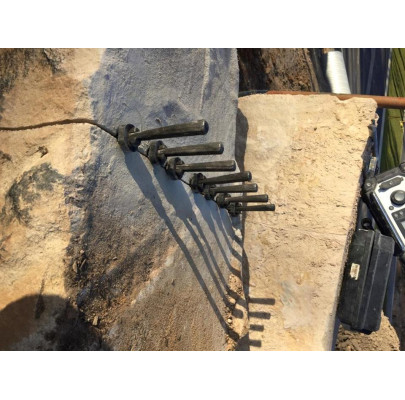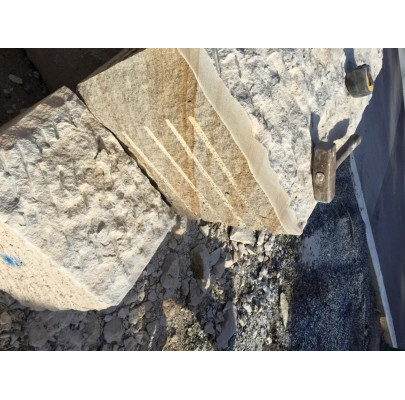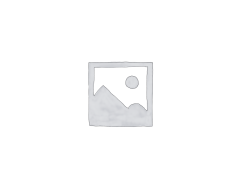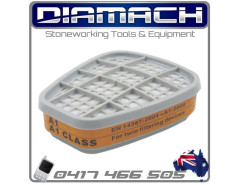Diamach Wedge And Shims Plug And Feathers Rock and Stone Splitting Tool 14mm
New design incorporates rubber ring to hold the set together, no more lost feathers/shims!
Longer wedge/plug for easier striking.
Great quality casting for long life.
Available in these sizes:
Diameter(mm) Length(mm)
38 320
34 290
32 280
24 190
20 190
16 125
14 125
12 125
Wedges & Shims
Guide to Splitting Stone
The use of wedges and shims is one of the oldest and most effective ways to split stone, whether you are trying to persuade a stone to split into a particular size and shape or simply reducing the size of a boulder to make it easier to move.
However, stone type, shape, size and other conditions can have a significant influence on how any particular stone may split. The basic steps and recommendations we have outlined below will help you achieve the best results.
Getting Started
Size Selection: Measure the height or thickness of the stone. Wedges & Shims can generally split stone up to 4-6 times the length of the wedge. (e.g., The wedge of our ¾in Wedge & Shims is 4in long, so it is reasonable to assume it can split a stone that is between 16-24in thick/high.)
Drill Bit Selection: Match the drill bit diameter to the Wedges & Shims. The “size” of the Wedges & Shims signifies the hole diameter. (e.g. ¾in Wedges & Shims require a ¾in diameter hole.) Make sure the drill bit can drill deeper than the length of the wedge.
Quantities: Wedges & Shims generally need to be placed every 4-6in along the “top” of the split plane. If splitting a rounded boulder, holes would be drilled every 4-6in in an “arch” across the top of the stone. Placing Wedges & Shims down the sides of the stone can help promote a straighter split through the stone.
**NOTE FOR SOFT STONE OR DIFFICULT SPLITS: Consider drilling holes closer together and/or deeper into the stone to help weaken the stone along the split plane. This may also help increase the splitting capacity of the Wedges & Shims when faced with a difficult or precise split, or when circumstances limit the hole diameter that can be drilled.
Preparing the Stone
Stone Location: If possible, position the stone (or choose a split plane) that will allow an isolated portion of stone to fall away from your split. (e.g. Place the stone on a piece of lumber to create a fulcrum on the bottom side of the split plane.) When splitting stones that are partially buried or splitting off sections of ledge/bedrock, expose as much of the stone as possible and focus on splitting off fully exposed sections of stone.
Layout Holes: Use a straight edge to mark hole locations very 4-6in on-center across the top and sides of the stone (if necessary). This will establish your intended split plane. Keep the first and last holes about 4-6in away from the outside edges of the stone.
Drilling Holes: Hold drill upright and steady during drilling to ensure each hole is plumb or drilled along the same split plane. Drill holes at least 1/4in deeper than the length of the wedge. Clear the holes of any excess stone dust.
Making the Split
Wedge & Shims Placement: When properly positioned, about 2/3rds of the wedge should protrude above the hole from between the two shims. It is helpful to preassembling the Wedges & Shims in this position before placing them in the hole. Make sure the shims are positioned perpendicular to the split line (i.e. not facing hole to hole).
Splitting: Use a light hammer to start tapping the wedges in sequence, firmly but without forcing, to build gradual, even pressure along the entire line of Wedges & Shims. Aggressive or forceful hammering will cause unnecessary damage and wear to the Wedges & Shims. If the wedges become too firm before a crack develops, allow the Wedges & Shims to briefly “rest” before continuing to drive the wedges into the stone.























Excellent phone manner and fast delivery
Great products and dast delivery.
Very Efficient & Helpful Service and Swift Delivery